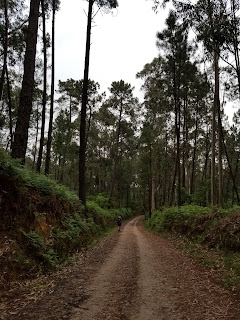Final 100 km of the Camino Portuguese: Tui to Saxamonde
Final 100 km of the Camino Portuguese
Camino Pilgrimage
Unfortunately, we forgot/ failed to think of several things. When we crossed the Spanish border the time jumped ahead by an hour. This meant it was still pitch dark at 6 am, unlike on previous days. We also didn't expect to find all the bars and cafes firmly closed, leaving us without any options for breakfast.
We reached the edge of town fairly quickly and then headed into a stretch of dirt road through a lovely forested area. On the way in we passed a large metal pilgrim statue, as well as an old stone bridge, and several works of pilgrim art, but it was still a bit dark to see anything very clearly. Even at this early hour, there were other pilgrims on the trail ahead of us.
As we crossed through the forest we saw several hanging insect traps, showing evidence of ecological research being carried out. We also passed several stone crosses at which pilgrims had left ribbons, stones, notes, and other talismans, lending a definite atmosphere of the Camino Frances. At one point we also passed Helen in the forest.
Since we didn't find breakfast, we took the main route where the path split so that we could visit a cafe. After a coffee, we tried to head back to the fork to take the alternative route through the forest, but couldn't immediately find the split. We decided that spending time trying to go backwards probably wasn't productive, and so decided to forge ahead through the industrial area.
This part of the hike was just about as charming as it sounds. The road took us through busy working factories, which were noisy, smelly, and busy. After that, the trail turned onto a busy main road that led into the large working town of Porrino. There were quite a few bars, restaurants, and cafes on this stretch, and we stopped for a second coffee.
We walked through Porrino pretty much without stopping. It seemed like a large town with all the amenities. The Way took us down a busy pedestrian thoroughfare, which featured many shops and restaurants. We also passed a large church, which was closed, a fountain, and several other architecturally interesting-looking buildings.
Since we were planning to continue on, and hoping to outrun the rain, we headed out of town and began climbing into the hills. The landscape in the distance was heavily forested, but we could also see several large quarries scarring the nearby hills. In some parts, the mountains looked so steep that they were treeless.
The path became an ash vault road and wound through small hillside towns. These towns had a very different feel from the brightly coloured, stuccoed and tiled villages of Portugal, with their tidy, flower-filled gardens. It was beautiful, and the forested hills surrounding us began to disappear into the mist.
When we reached the Santa Ana hostel after Porrino we briefly considered stopping, but as it didn't open for another 5 hours, it wasn't a hard decision to keep going, light rain or no.
Originally we had planned to continue to a town called Mos. Just before we reached it a heavy mist began to fall. We ducked into the first cafe we came to and found it full of well-dressed German pilgrims, none of whom looked wet, dirty, or weighed down by heavy knapsacks. They seemed to be enjoying wine and coffee, and waiting in the warmth. We had a coffee and waited to see if the rain would stop.
Final 100 KM on the Camino Portuguese
We had been thinking of stopping in the Albergue in Mos, but it was only 11:30 am when we found ourselves outside of it, and so we would still have had 1.5 hours to wait until it opened. It was raining only very slightly, so we continued another 6.7 km to the Albergue O Corisco in Saxamonde.
After Porrino we began to see a definite increase in the number of pilgrims on the trail. Although I would say there were always at least three in view, there weren't as many as there were in the last 100 km of the Camino Frances. Even so, there is still the tension between the hikers who started before Tui and are somewhat accustomed to walking and the daily routines of the pilgrims, and those people who have joined the route in Tui and who are struggling to walk, adjust their packs, manage their poles, look around, not get lost, and pretend it's easy, all at the same time.
Today it was a struggle not to feel jaded and cynical, and it makes me wonder what lessons the next four days will hold for us. We were once again extremely lucky and grateful today to be spared from the heavy rain and to find a warm, safe, friendly place to stop.
We reached the O Corisco bar and albergue slightly after noon, after descending on the steepest asphalt roads I've ever walked down. It was just beginning to rain, so it was good timing. We were met by a very nice Spanish lady who took us up to the albergue, and after we'd had a shower served us a pint and an enormous sandwich each in the bar. It is a very nice, clean place with a good view down the valley. We were a little dispirited to find condoms and lube in the lockers and drawers of the Albergue, but I guess they signal the same change in tone that was evident from the Coca-Cola machines with Camino shells on them we saw earlier.
Accommodations: O Corisco Abergue
Distance: 30.8 km
































Comments
Post a Comment